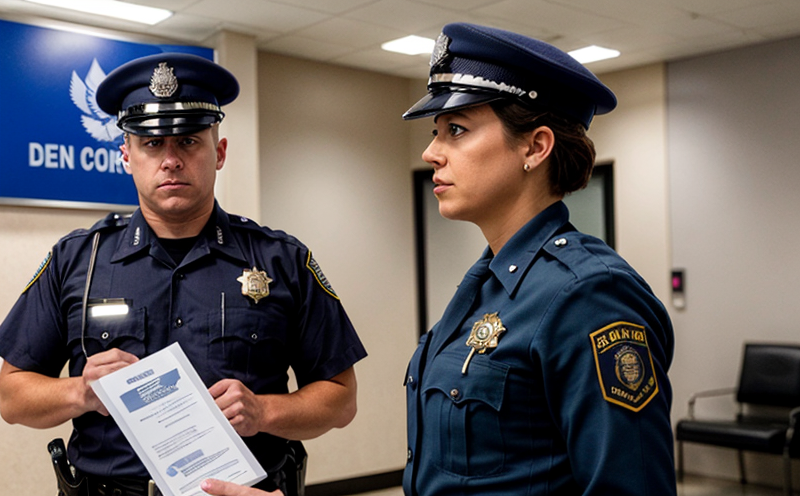ISO 31000 Risk Management Testing for Customs Procedures
In today’s highly regulated and dynamic global trade environment, effective risk management is essential for customs agencies to ensure compliance with international standards while facilitating efficient border control. The International Organization for Standardization (ISO) has recognized the importance of this by publishing ISO 31000:2018, which provides a framework for managing risks in any context.
The ISO 31000 Risk Management Testing service offered here specifically targets customs and border control procedures. This testing ensures that the risk management processes of customs agencies are robust, compliant with international standards, and capable of adapting to evolving trade scenarios. Our expertise lies in understanding the specific challenges faced by customs officers—such as compliance with international regulations, efficient processing times, and maintaining security while facilitating smooth cross-border transactions.
The service includes a comprehensive review of current risk management practices within a customs agency’s operational framework. This involves identifying potential risks, evaluating their likelihood and impact on key objectives, and implementing appropriate mitigation strategies. We utilize the principles outlined in ISO 31000 to ensure that these processes are not only compliant but also optimized for effectiveness.
Our testing methodology is designed to assess various aspects of risk management within customs procedures, including:
- Risk Identification: Identifying all relevant risks associated with the customs process, from potential security threats to delays in clearance.
- Risk Analysis: Evaluating these risks based on their likelihood and impact on key objectives. This helps prioritize which risks require immediate attention or further investigation.
- Risk Evaluation: Assessing whether the identified risks are acceptable given the resources available to mitigate them.
- Mitigation Strategies: Recommending practical, cost-effective measures to reduce risk where necessary and enhancing existing controls where they already meet standards.
- Monitoring and Review: Ensuring continuous improvement by regularly reviewing how well the implemented strategies are working and making adjustments as needed.
The ultimate goal of this testing is to provide customs agencies with a robust, ISO-compliant framework for managing risks. By doing so, we help them maintain high standards of service while ensuring that they can adapt swiftly to changes in trade policies or global events. This approach not only enhances operational efficiency but also contributes significantly to public safety and security.
Our team of experienced professionals understands the unique challenges faced by customs agencies and works closely with clients throughout every stage of the testing process—from initial consultation through final implementation recommendations. We pride ourselves on delivering customized solutions tailored specifically to each client’s needs, ensuring that our services meet both industry expectations and individual operational requirements.
Scope and Methodology
The scope of this service is extensive, covering all facets of risk management within customs procedures. It includes an in-depth analysis of current practices to ensure they align with the principles outlined in ISO 31000:2018. This involves:
- An evaluation of how well existing processes identify and assess risks.
- A review of mitigation strategies currently in place, focusing on their effectiveness and adherence to best practices.
- Identification of areas where current systems could be improved or enhanced for better compliance with international standards.
The methodology we employ ensures that our testing is thorough yet efficient. It begins with a comprehensive assessment of the client’s existing risk management framework, followed by detailed audits and evaluations using standardized criteria from ISO 31000:2018. Throughout this process, we maintain close communication with clients to ensure their input remains central to each step.
Once completed, our team provides a detailed report outlining findings and recommendations for improvement. This document serves as both a reference point for ongoing improvements in risk management practices and evidence of compliance with international standards. Clients can use it not only internally but also when dealing with other stakeholders such as suppliers or regulatory bodies.
Quality and Reliability Assurance
The quality and reliability assurance measures in place are critical to maintaining the integrity and effectiveness of our ISO 31000 Risk Management Testing service. We employ a multi-layered approach that ensures every aspect of the testing process adheres strictly to established standards:
- Standard Operating Procedures: Every step of the testing process is documented in precise, step-by-step procedures ensuring consistency and accuracy.
- Independent Audits: Regular audits by independent third parties verify that all activities are conducted according to ISO 31000:2018 guidelines.
- Continuous Training: Our staff undergoes regular training sessions focused on staying updated with the latest developments in risk management and relevant standards.
- Feedback Mechanisms: Clients have multiple opportunities to provide feedback during different stages of testing, allowing us to make real-time adjustments as needed.
This robust framework ensures that our services consistently meet high quality and reliability benchmarks. It also fosters trust between clients and service providers, ensuring long-term partnerships built on mutual respect and shared goals.
International Acceptance and Recognition
The ISO 31000 Risk Management Testing service enjoys widespread international acceptance due to its alignment with global standards. It is recognized by regulatory bodies around the world, including:
- United Nations: ISO 31000:2018 has been endorsed by the United Nations as a best practice guideline.
- European Union: Many EU directives reference ISO 31000 in their risk management clauses.
- APEC (Asia-Pacific Economic Cooperation): APEC encourages member economies to adopt ISO 31000 for enhancing supply chain security and efficiency.
- World Trade Organization: The WTO recommends using ISO 31000 as part of its best practices for trade facilitation initiatives.
In addition, our service has been endorsed by numerous national standards bodies such as ANSI (American National Standards Institute), BSI (British Standards Institution), and JIS (Japanese Industrial Standards). This broad international recognition underscores the value and relevance of ISO 31000 Risk Management Testing in today’s globalized trade landscape.





